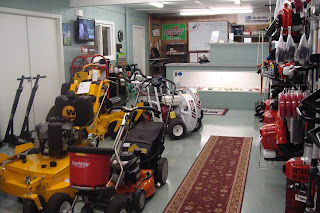Lawn Care Equipment
Your grass is healthy, green and thick as high pile carpet. But now the time has come to mow the lawn, edge the gardens and walkways, and trim the hedge. You know the lawn work needs to be done, but what lawn care equipment is available for you to use if you wish to implement green lawn mowing and maintenance? Before you spend hours at your local garden center, here are brief descriptions of standard lawn garden equipment.
Reel Mowers
A type of mower that uses blades on a revolving cylinder; it is powered by either engine or muscle These green lawn mowers make the healthiest, most even cut and is ideal for lawn mowing. Blades can be difficult to sharpen and should be brought to a professional
Rotary Mower
This achieves green lawn mowing by using flat horizontal blades controlled by an engine mounted on the mower deck Sharpening of the blades is a fairly simple and can be done by using a mill file and a rotary bench grinder. If not kept sharp, the blade will rip the grass instead of cutting it.
Walk Behind
Green lawn mowing at its best! The mower is powered by gas, electric, or by pushing the mower. They are environmentally friendly, require little maintenance and you get an extra workout every time you use it You need to be strong enough to push them.
Ride on Mower
Available in a array of sizes, styles and have a variety of add-ons for your convenience and ease of use; great for large yards Can be fitted for environmentally friendly engines or electric motors. They are expensive and heavier than other mowers which causes soil compaction
Additional lawn care equipment includes:
Ear & eye protection – Keep your eyes safe from dust or debris by weary safety goggles. For your ears, the National Institute if Deafness and Other Communication Disorders recommends that you protect your ears form sounds that are over 85 decibels—as the majority of trimmers and mowers exceed this number be sure you protect your ears.
No-spill gas cans – Help keep you, your family, and the environment safe and clean.
Watering utensils – hoses, rain gauges, sprinklers, etc.
Wheelbarrows – one of the simplest yet most useful pieces of lawn garden equipment
Rakes – A leaf rake, a metal rake, a bamboo rake and (optional) a landscaping rake
String trimmers
RedMax /EFCO trimmers include solid-steel drive shafts that are splined on both ends. This reduces vibration and improves acceleration, creating a much higher load-carrying capacity. The result is an efficient, low-friction, smooth-running machine that is comfortable to use. Solid-steel drive shaft systems deliver trouble-free operation with no maintenance and downtime when compared to flex-cable or flex-shaft units.
Now, it’s up to you—how will you decide what type of mower will work best? Use these quick guidelines for green lawn mower selection:
Powered or manual? If your yard is less than 2000 sq. ft., go manual.
Decide whether you want a mower with or without a bag for debris.
Determine whether a rotary blade or a reel mower will best suit your situation.
Lawn care equipment doesn’t have to be scary. Know what you want, take your time, then go out and hit the green!
brought to you by imperialservicesinc.com














